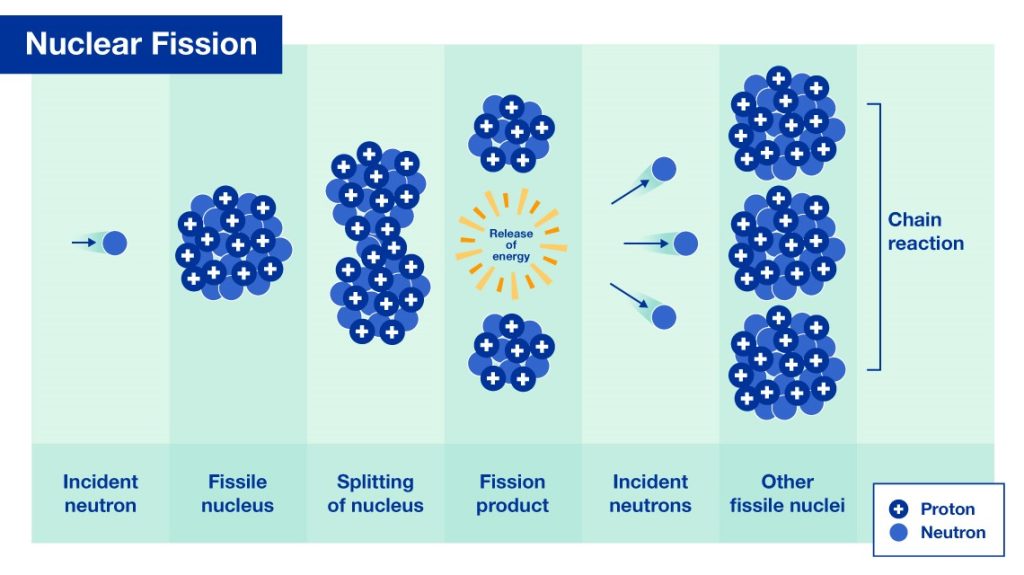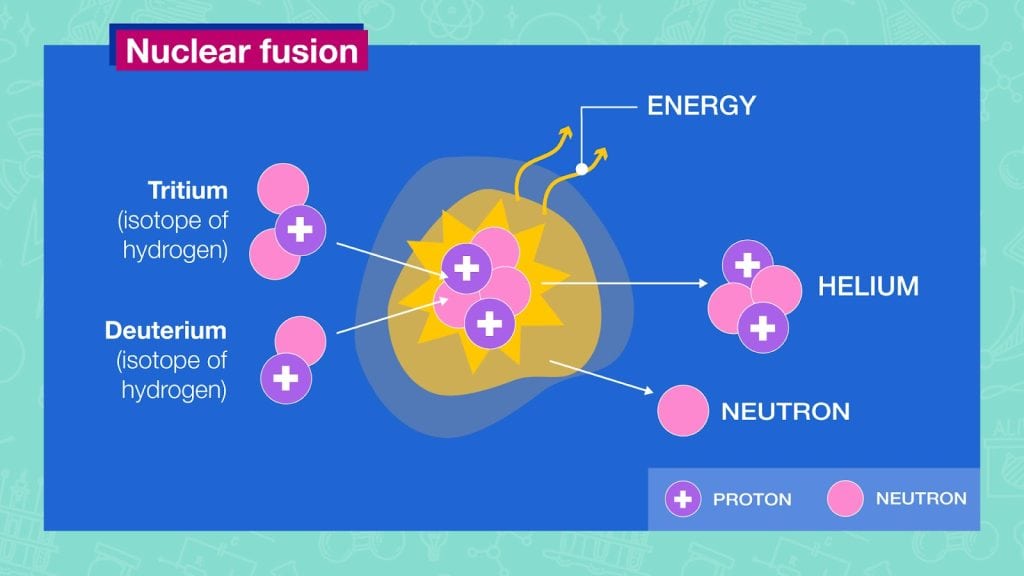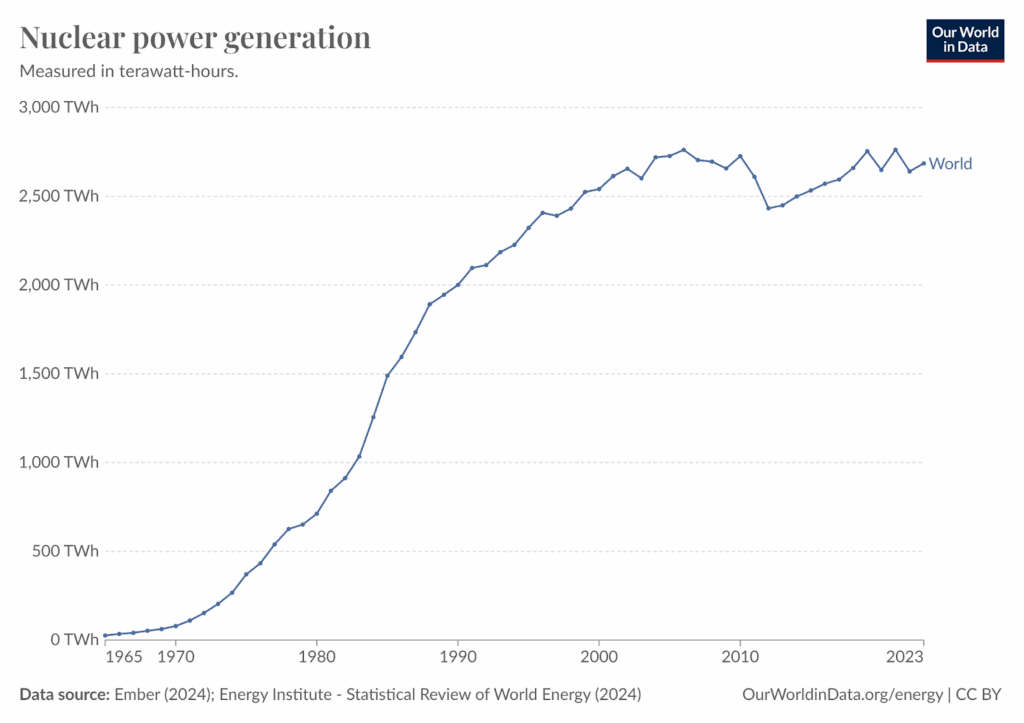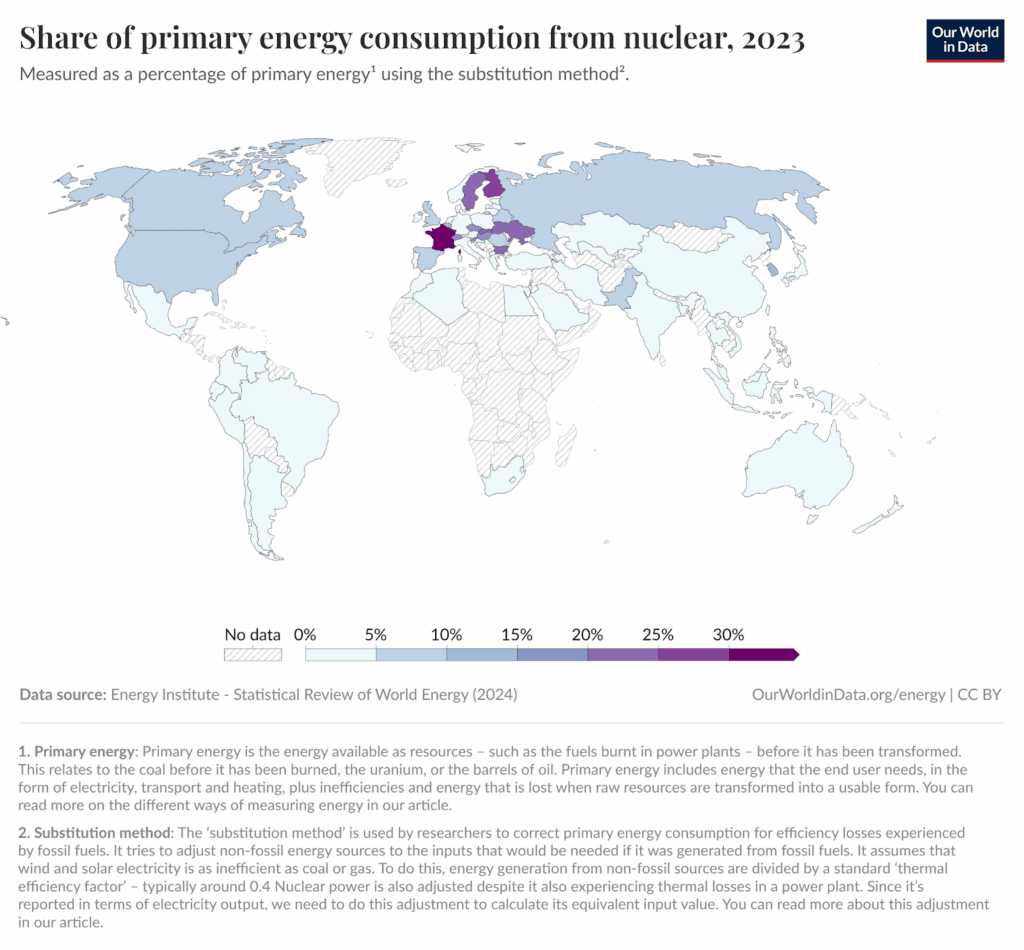Nuclear Power Explained: All You Need to Know
Affiliate Disclosure
Hey fellow impactful ninja ?
You may have noticed that Impactful Ninja is all about providing helpful information to make a positive impact on the world and society. And that we love to link back to where we found all the information for each of our posts.
Most of these links are informational-based for you to check out their primary sources with one click.
But some of these links are so-called "affiliate links" to products that we recommend.
Why do we add these product links?
First and foremost, because we believe that they add value to you. For example, when we wrote a post about the environmental impact of long showers, we came across an EPA recommendation to use WaterSense showerheads. So we linked to where you can find them. Or, for many of our posts, we also link to our favorite books on that topic so that you can get a much more holistic overview than one single blog post could provide.
And when there is an affiliate program for these products, we sign up for it. For example, as Amazon Associates, we earn from qualifying purchases.
What do these affiliate links mean for you?
First, and most importantly, we still only recommend products that we believe add value for you.
When you buy something through one of our affiliate links, we may earn a small commission - but at no additional costs to you.
And when you buy something through a link that is not an affiliate link, we won’t receive any commission but we’ll still be happy to have helped you.
What do these affiliate links mean for us?
When we find products that we believe add value to you and the seller has an affiliate program, we sign up for it.
When you buy something through one of our affiliate links, we may earn a small commission (at no extra costs to you).
And at this point in time, all money is reinvested in sharing the most helpful content with you. This includes all operating costs for running this site and the content creation itself.
What does this mean for me personally?
You may have noticed by the way Impactful Ninja is operated that money is not the driving factor behind it. It is a passion project of mine and I love to share helpful information with you to make a positive impact on the world and society. However, it's a project in that I invest a lot of time and also quite some money.
Eventually, my dream is to one day turn this passion project into my full-time job and provide even more helpful information. But that's still a long time to go.
Stay impactful,
Nuclear power has faced criticism for its use of radioactive materials to generate electricity. But the process produces little to no carbon dioxide (CO2) emissions or other greenhouse gasses (GHGs). So, we had to ask: What is nuclear power really, and how could it help us mitigate climate change?
Nuclear power is created through either nuclear fusion or nuclear fission. Per kWh produced, nuclear power emits 12 grams of CO2 on a life-cycle basis. It combats climate change and has various environmental benefits, but can come with the threat of nuclear waste products.
Keep reading to find out all about what nuclear power is, its global capacity, its carbon footprint, its environmental benefits and drawbacks, and how it can combat climate change.
The Big Picture of Nuclear Power
In general, nuclear power is generated when neutrons either divide or fuse, which releases heat, produces steam, spins a turbine, and drives generators to produce electricity.
The two ways we can generate nuclear power are via nuclear fission (when neutrons divide) or nuclear fusion (when neutrons fuse).
How Is Nuclear Power Defined
Nuclear fission is the generation of energy produced when splitting apart the nucleus of an atom.
“Nuclear fission: a nuclear reaction in which a heavy nucleus splits spontaneously or on impact with another particle, with the release of energy.”
Cambridge Dictionary
Nuclear fusion is the generation of energy produced when lighter atoms are combined or fused to create larger and heavier atoms.
“Nuclear fusion: the process of joining two nuclei to produce energy.”
Cambridge Dictionary
All operating nuclear power plants today utilize the process of nuclear fission, whereas nuclear fusion is still very much in the research and development phase.
Are you interested in learning more about nuclear fission or nuclear fusion? Check it out in these articles here:
| What nuclear power is | Nuclear power is generated when the nucleus of an atom is divided or joined to another nucleus. |
| How nuclear power works | The energy created when neutrons either fuse or divide releases energy in the form of heat which produces steam, spins a turbine, and drives generators to produce electricity. |
| The global capacity of nuclear power | Currently, Nuclear energy accounted for roughly 9% of global electricity generation in 2023, generating 2,685 TWh of electricity from 440 power reactors with over 400 GW of installed capacity. |
| The carbon footprint of nuclear power | On a life-cycle basis, nuclear power emits 12 grams of CO2 equivalent per kilowatt-hour (kWh) of electricity produced. |
| The environmental benefits of nuclear power | Nuclear fission has a low carbon footprint, protects air quality, has a small land footprint, and generates few waste products. |
| The environmental drawbacks of nuclear power | Nuclear fission is a nonrenewable energy source that can negatively impact the environment with the threat of nuclear waste. |
| Nuclear power and climate change | Nuclear power combats climate change because it is a reliable, efficient, and low-carbon emission source of energy. |
How Does Nuclear Power Work
In general, nuclear power is generated when neutrons either fuse or divide, which releases heat, produces steam, spins a turbine, and drives generators to produce electricity.
How Does Nuclear Power Actually Produce Energy
The two ways to generate nuclear power are via nuclear fusion and nuclear fission.
Nuclear fission is the process by which neutrons are used to split the nucleus of a Uranium-235 atom,which releases an enormous amount of energy in the form of heat and radiation. Each time the reaction occurs, more neutrons are free to strike more and more nuclei, causing a chain reaction.

Nuclear fission power plants generally operate in the following manner:
- The reactor starts and U-235 atoms in the reactor core split (fission), releasing heat and neutrons.
- Neutrons fission other nuclei in the reactor core in a chain reaction, generating more heat and more neutrons.
- Control rods contain materials that absorb some of the neutrons, helping to contain the chain reaction.
- The heat generated turns water that surrounds the immersed reactor into steam.
- The steam spins a turbine which drives a generator to produce electricity.
Nuclear fusion is the process by which lighter atoms are combined or fused to create larger and heavier atoms. Nuclear fusion is still in the research and development phase.

Nuclear fusion power plants generally operate in the following manner:
- Deuterium and tritium (isotopes of hydrogen) are introduced into a fusion reactor and heated upwards of 150 million degrees Celsius
- The deuterium and tritium fuse together, forming an electrically charged gas known as plasma and releasing massive amounts of energy and neutrons
- A lithium blanket surrounding the core of the fusion reactor absorbs the kinetic energy of the neutrons, causing the blanket to heat up
- As the blanket heats up, the lithium is transformed into tritium (which is used to fuel the reaction) and helium
- The energy, in the form of heat, is collected by the coolant (water, helium, or Li-Pb eutectic) flowing through the blanket
- The heat can be used to generate electricity
The sun and stars get their energy from nuclear fusion, as hydrogen atoms fuse together to form helium and matter converts into energy. However, the fusion process is very hard to control within a laboratory setting. More still needs to be done to determine if this could be another viable energy source.
What Is the Global Capacity of Nuclear Power
Nuclear power accounted for roughly 10% of global electricity generation in 2022, generating approximately 2,500 TWh of electricity from approximately 413 GW of installed capacity.

Nuclear energy provides 25% of the world’s low-carbon electricity, making it our second-largest source. Some countries rely heavily on nuclear energy whilst others have not yet tapped into the resource. For example, nuclear provides roughly 70% of France’s and 50% of Ukraine, Slovakia and Hungary’s electricity, but South America and Africa get virtually no energy from nuclear.

The future of nuclear power remains uncertain. Although it can produce relatively emissions-free energy and adjust its energy output to compensate for shifts in renewable energy output, nuclear fission also faces high upfront costs and negative public opinion.
Historically, the United States has led the way in terms of nuclear power, with 93 operating commercial nuclear reactors at 54 nuclear power plants. But more recently, China has emerged as a global leader in nuclear power. China currently has 27 nuclear reactors under construction and aims to build 150 more reactors between now and 2035. In comparison, the US only has 1 new reactor under construction.
The IEA has labeled nuclear power as ‘more efforts needed’ in their Net Zero by 2050 Scenario, a framework for the global energy sector to achieve net zero CO2 emissions by 2050 and universal energy access by 2030.
In terms of capacity additions, nuclear power capacity must increase to 545 GW by 2030 to stay on track in the net zero scenario. Currently, there are about 65 nuclear reactors under construction in 15 countries, most notably in China, India, and Russia.
What Is the Carbon Footprint of Nuclear Power
The carbon footprint is one of the ways we measure the effects of human-induced global climate change. It primarily focuses on the GHG emissions associated with consumption, but also includes other emissions such as methane (CH4), nitrous oxide, and chlorofluorocarbons.
“Carbon footprint: the amount of greenhouse gasses and specifically carbon dioxide emitted by something (such as a person’s activities or a product’s manufacture and transport) during a given period”
Merriam Webster
Basically, it is the amount of carbon emitted by an activity or an organization. This includes GHG emissions from fuel that we burn directly (e.g., heating a home, driving a car) and GHG emissions from manufacturing the products that we use (e.g., power plants, factories, and landfills).
All operating nuclear power plants today utilize the process of nuclear fission. Because of this, nuclear fission is commonly referred to simply as ‘nuclear power’ in the data and literature.
On a life-cycle basis, nuclear power (nuclear fission) emits 12 grams of CO2 equivalent per kilowatt-hour (kWh) of electricity produced, which is tied for the third-lowest out of all energy types.
Have a look at the illustration below to see the average life-cycle CO2 equivalent emissions of different energy sources and how they compare to nuclear.

To understand the carbon footprint of nuclear power, we must assess its life-cycle and each stage’s carbon footprint. This life-cycle assessment (LCA) is a method to evaluate the environmental impacts of products and materials. Over the years, companies have strategically used LCA to research and create more sustainable products. So, let’s have a look at the LCA of nuclear power!
When discussing the carbon footprint of nuclear power, we must take into account carbon emissions across the energy’s building, operating, and building back phases.
| The life-cycle stages of nuclear power | Each stage’s carbon footprint |
| Building of nuclear power | Emissions at this stage occur when constructing the power plant and reactors, gathering and processing the input materials, and transporting the materials to the power plant. |
| Operating of nuclear power | There are very few CO2 emissions or waste products associated with operating and maintaining nuclear power, making this stage very clean. |
| Building back of nuclear power | Emissions at this final stage occur when utilizing construction equipment to decommission nuclear sites, demolish buildings, restore the surrounding land, and construct new buildings in the old nuclear power plant’s place. |
How Environmentally Friendly Is Nuclear Power
Overall, nuclear power is not considered to be environmentally friendly.
“Environmentally friendly: (of products) not harming the environment.”
Cambridge Dictionary
Nuclear power varies in environmental friendliness. The operating and maintenance stage is more environmentally friendly when compared to the building and building back stages.
What Are Environmental Benefits of Nuclear Power
Nuclear power has a low carbon footprint, protects air quality, and generates few waste products. In addition, nuclear fusion cannot cause a nuclear accident or be used to produce nuclear weapons.
| 5 Environmental Benefits of Nuclear Power | Quick Facts |
| Benefit #1: Nuclear power has a low carbon footprint | On a life-cycle basis, nuclear power emits 12 grams of CO2 equivalent per kWh of electricity produced, the second lowest out of all fuel types. |
| Benefit #2: Nuclear power protects air quality | Nuclear power is a clean burning source of energy that produces minimal greenhouse gasses and emits no CO, SO2, or NOx, thereby helping to protect air quality. |
| Benefit #3: Nuclear power generates few waste products | Nuclear power produces substantially less waste than other forms of energy and only a small amount of high-level, radioactive waste. |
| Benefit #4: Nuclear fusion cannot cause a nuclear accident | Nuclear fusion reactions cannot cause a nuclear accident because they are not based on chain reactions. |
| Benefit #5: Nuclear fusion cannot be used to produce nuclear weapons | Nuclear fusion cannot be used to produce nuclear weapons because it does not use fissile material and uses only a small amount of fuel. |
What Are The Environmental Drawbacks of Nuclear Power
Nuclear power generates nuclear waste with varying radioactivity. In addition, nuclear fission is a nonrenewable resource that can negatively impact the environment.
| 3 Environmental Drawbacks of Nuclear Power | Quick Facts |
| Drawback #1: Nuclear power generates nuclear waste | Nuclear power produces nuclear waste that is radioactive and can remain hazardous for many years, depending on the type. |
| Drawback #2: Nuclear fission is a nonrenewable energy source | Nuclear fission is classified as nonrenewable energy because nuclear fuel (Uranium) is a finite material that can only be found in certain locations in the Earth’s crust. |
| Drawback #3: Nuclear fission can negatively impact the environment | Uranium mining can contaminate the environment with radiation, water-borne toxins, and radon gas. |
Why Is Nuclear Power Important to Fight Climate Change
Climate change is arguably the most severe, long-term, global impact of fossil fuel combustion. Every year, approximately 37 billion tons of CO2 are emitted from burning fossil fuels. The carbon found in fossil fuels reacts with oxygen in the air to produce CO2. This warms the earth by acting as a heating blanket, and a warmer earth comes with a host of negative side effects.
Using nuclear power instead of fossil fuel energy helps mitigate the following negative effects of climate change:
- Increasing temperatures: Earth’s atmosphere has warmed 1.5°C since 1880. This may not seem like a lot, but these degrees create regional and seasonal temperature extremes, reduce sea ice, intensify rainfall and drought severity, and change habitat ranges for plants and animals.
- Rising sea levels: Global sea levels have increased approximately 8-9 inches since 1880, displacing people living along coastlines and destroying coastal habitats. Roads, bridges, subways, water supplies, oil and gas wells, power plants, sewage treatment plants, and landfills remain at risk if sea level rise goes unchecked.
- Melting of sea ice: Since 1979, arctic sea ice has declined by 30%. Sea ice plays a major role in regulating the earth’s climate by reflecting sunlight into space and providing habitat for animal species. If all of the glaciers on Earth melted, sea levels would rise by approximately 70 feet, effectively flooding out every coastal city on the planet.
- Changing precipitation patterns: Extreme weather events (e.g., hurricanes, floods, droughts) are becoming more common and more intense. Storm-affected areas will experience increased precipitation and flooding whereas areas located further from storm tracks will experience decreased precipitation and droughts.
- Ocean acidification: The ocean absorbs 30% of the CO2 released into the atmosphere, which decreases the pH (increases the acidity) of the ocean. In the past 200 years, the pH of oceans has decreased by 0.1 pH units, which translates to a 30% increase in acidity. Aquatic life unable to adjust to this rapid acidification will die off. A prime example of this is coral bleaching, where coral expels the algae (zooxanthellae) living in their tissues as a result of changes in temperature, light, or nutrients.
The more we reduce CO2 emissions, the more we slow the rate of temperature rise, sea-level rise, ice melting, and ocean acidification. When these rates are slowed, the earth’s biodiversity does not have to struggle to adapt to temperature and pH changes. People will not be displaced due to the flooding of coastal areas. And icebergs will continue to provide climate regulation.
To help keep global temperature rise below 1.5C, as outlined in the Paris Agreement, we must shift at least 80% of our electricity generation to low carbon sources. Over 120 countries have already stated their net-zero carbon emissions ambitions for 2050 or 2060. But only 12 countries have thus far proposed or enacted any legislation, indicating that there is more work to be done.
Final Thoughts
Nuclear power is an incredibly efficient energy source that uses heat acquired from either fusing or splitting the nuclei of atoms to create electricity. Nuclear fusion produces no CO2 emissions and nuclear fusion produces minimal CO2 emissions. The capacity for nuclear power is great, but few countries currently source any or most of their energy from nuclear power.
Nuclear power benefits the environment by mitigating climate change, creating jobs, promoting energy independence, and protecting air quality. Environmental drawbacks associated with nuclear fission include uranium mining and nuclear waste but can be mitigated with proper handling and disposal methods. Nuclear fusion is still in the research and development phase, and more time is needed to perfect the process in a laboratory setting.
Stay impactful,

Sources
- Impactful Ninja: Nuclear Power Explained: All You Need to Know
- Impactful Ninja: Nuclear Fission Explained: All You Need to Know | Impactful Ninja
- Impactful Ninja: Nuclear Fusion Explained: All You Need to Know
- International Atomic Energy Agency: What is Nuclear Energy? The Science of Nuclear Power
- World Nuclear Association: Nuclear Fusion Power
- Nuclear Energy Institute: Here’s How a Nuclear Reactor Actually Works
- Natural Resources Defense Council: Nuclear Power 101
- US Nuclear Regulatory Commission: Control Rod
- International Atomic Energy Agency: What is nuclear fusion
- Fusion for Energy Europe: Nuclear Fusion Energy: the energy of the Stars
- World Nuclear Association: Nuclear Power in the World Today
- Our World in Data: Nuclear power generation
- US Energy Information Administration: US nuclear industry
- CNBC: How China became the king of new nuclear power, and how the US is trying to stage a comeback
- Information Technology & Innovation Foundation: How Innovative Is China in Nuclear Power?
- International Energy Agency: Nuclear power capacity by country or region in the Net Zero Scenario
- World Nuclear Association: Plans For New Reactors Worldwide
- Britannica: Carbon footprint | Definition, Examples, Calculation, Effects, & Facts
- United States Environmental Protection Agency: System of Registries
- World Nuclear Association: Carbon Dioxide Emissions From Electricity
- Impactful Ninja: What Is the Carbon Footprint of Nuclear Power? A Life-Cycle Assessment
- Science Direct: Life-cycle assessment (LCA)
- MIT SMR: Strategic Sustainability Uses of Life-Cycle Analysis
- Impactful Ninja: How Environmentally Friendly Is Nuclear Power? A Life-Cycle Assessment
- World Nuclear Association: Nuclear Energy and Sustainable Development
- World Nuclear Association: What is nuclear waste and what do we do with it?
- ITER: Advantages of fusion
- Impactful Ninja: The 5 Main Environmental Benefits of Nuclear Power: The Big Picture
- National Grid Group: Why is nuclear a clean energy?
- National Institute of Health: Uranium mining and health – PMC
- Impactful Ninja: The 3 Environmental Drawbacks of Nuclear Power: The Big Picture
- The National Wildlife Federation: Climate Change
- National Oceanic and Atmospheric Administration: Climate Change – Global Temperature
- National Oceanic and Atmospheric Administration: Climate Change – Global Sea Level
- United States Geological Survey: How would sea level change if all glaciers melted?
- National Aeronautics and Space Administration, USA: How does climate change affect precipitation?
- National Oceanic and Atmospheric Administration: Ocean Acidification
- National Ocean Service: What is coral bleaching?
- United Nations Framework Convention on Climate Change: The Paris Agreement
- International Energy Agency: Oil 2021















